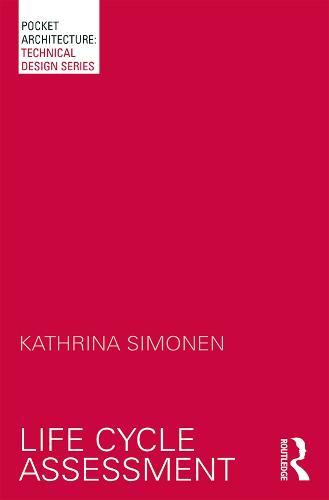Full Product Details
Author: Kathrina Simonen (University of Washington, USA) ,
Kathrina Simonen
Publisher: Taylor & Francis Ltd
Imprint: Routledge
Weight: 0.500kg
ISBN: 9780415702416
ISBN 10: 0415702410
Pages: 182
Publication Date: 10 April 2014
Audience:
College/higher education
,
Professional and scholarly
,
Postgraduate, Research & Scholarly
,
Undergraduate
Format: Hardback
Publisher's Status: Active
Availability: In Print

This item will be ordered in for you from one of our suppliers. Upon receipt, we will promptly dispatch it out to you. For in store availability, please contact us.
Reviews
'Assistant professor of architecture Kathrina Simonen writes on the practice of life cycle assessment, authoring the handbook that she herself sought while wrestling with pressing questions of building, environment and quantification. Simonen positions LCA as an 'emerging discipline,' contextualizes LCA within its strengths, weaknesses and limitations, and dispels for the architect any attempt to idealize the practice. She translates what oft appears as a confounding method with concise and accessible language, case studies, didactic diagrams, and the aplomb to continuously remind us where methods require refinement, debate and consensus. An architect who has intuitively uttered the phrase 'embodied environmental impacts' in relation to a building, component or material - one who has desired a way of knowing environmental impacts more fully - will find herein a thorough discussion of the topic and description of the method. Simonen's handbook is timely and necessary as the building industry self-organizes to adopt environmental assessment methods pervasively and proactively for design decision making.' - Billie Faircloth, KieranTimberlake 'Professor Simonen expertly bridges the gap between the practices of building design and life cycle assessment and her book is another testament to that. It gives comprehensive guidance to understanding and implementing LCA from a uniquely US architect's perspective.' - Frances Yang, Structures and Sustainability Specialist, Arup
‘Assistant professor of architecture Kathrina Simonen writes on the practice of life cycle assessment, authoring the handbook that she herself sought while wrestling with pressing questions of building, environment and quantification. Simonen positions LCA as an ‘emerging discipline,’ contextualizes LCA within its strengths, weaknesses and limitations, and dispels for the architect any attempt to idealize the practice. She translates what oft appears as a confounding method with concise and accessible language, case studies, didactic diagrams, and the aplomb to continuously remind us where methods require refinement, debate and consensus. An architect who has intuitively uttered the phrase ‘embodied environmental impacts’ in relation to a building, component or material - one who has desired a way of knowing environmental impacts more fully - will find herein a thorough discussion of the topic and description of the method. Simonen’s handbook is timely and necessary as the building industry self-organizes to adopt environmental assessment methods pervasively and proactively for design decision making.’ - Billie Faircloth, KieranTimberlake 'Professor Simonen expertly bridges the gap between the practices of building design and life cycle assessment and her book is another testament to that. It gives comprehensive guidance to understanding and implementing LCA from a uniquely US architect's perspective.' - Frances Yang, Structures and Sustainability Specialist, Arup
Author Information
Kathrina Simonen is an Assistant Professor in the Department of Architecture at the University of Washington. Licensed as both an Architect and Structural Engineer, her research agenda stems from unresolved questions originated during over 15 years of professional practice. Her research topics include life cycle assessment (LCA) and practice innovations such as prefabrication, digital manufacturing, and alternative project delivery models. She is founding director of the Carbon Leadership Forum, an industry/academic research collaborative focused on linking the science of life cycle assessment to industry best practices in order to help enable quantifiable reduction of the environmental impact of the built environment.




